
BRAC
Aarong

Empowering crafters in a nutshell
As one of Bangladesh's largest fashion retail chains under the umbrella of one of the world’s largest NGOs, Aarong’s flagship outlet also claims the largest retail space in the country as part of its presence in the Uttara district of Dhaka. Fighting to uphold the dignity of the marginalised, this chic brand began as a humble project. After it’s initiation as a project to provide employment for a limited number of rural women through silk production via sericulture and the art of nakshikantha(embroidered quilts) in 1978, Aarong extended its support to rural artisans by investing in their handicrafts for several years into its operations. In the process, it saw the emergence of independent producers and created income generating opportunities for thousands of artisans from communities beyond the reach of BRAC. Weaving together new opportunities for people with the skilled work of their artisans, Aarong has carved out a unique market segment, giving hope to the crafters.
How it all started
When BRAC started its journey in 1972, the initial goal was to serve as a relief operations committee for a designated amount of time. Once its relief operations were underway, BRAC reasoned that providing limited relief to the rural poor was not a lasting solution for them to overcome poverty, as in the newly sovereign Bangladesh almost everything - including the economic infrastructure of the country - was left upturned. After the completion of its relief operations, BRAC shifted its focus to empowering the poor, forming a long term approach to community development. Around 1976, while operating its targeted group approach, BRAC realised that the most disadvantaged groups in poor rural communities were women, and required a route that would empower this group while also providing income generating opportunities.
BRAC began encouraging silk farming by women in Bangladesh’s Manikganj district. Initially, BRAC had a few scattered buyers in Dhaka, with weeks or even months passing between supply and payment. Today, the process is much more streamlined and efficient as BRAC established Aarong, whose artisans represent the cutting edge of social enterprise. Through BRAC’s innovative approach, the global community now has a prime example of how targeted mobilisation of the poor can support sustainable development efforts, while also generating a financial surplus.
The birth of Aarong
BRAC observed that women in Bangladesh were increasingly involved in agricultural activities. It also recognised that it was the male members of families who marketed the crops and reaped the profits, even though women completed about 75 percent of the agricultural work. In order to create an alternative opportunity to earn an income for these women and contribute to the development of a skilled workforce, BRAC established its sericulture project in 1978 under the leadership of the late Ayesha Abed, former executive assistant director of BRAC.
The sericulture project has supported women in the rural areas of Manikganj in producing high quality silk, and women in rural communities of Jamalpur in producing traditional hand-stitched nakshikantha. However, it soon became apparent that the women producing the silk and nakshikantha did not have sufficient buyers for their products, nor were there any stable platforms for them to market their items. Seeing the opportunity that lay in the challenge, BRAC took the initiative to create a platform so that these women could sell their products to the urban market. Thus, Aarong was launched in 1978, creating a linkage between the rural poor and urban retailers.
Since its inception, Aarong, which means 'village fair' in Bengali, has been working towards BRAC’s mission of poverty alleviation through economic development and human capacity building, with a specific focus on the empowerment of women. The retail process follows several steps: first, a design team conceptualises the season’s motives which are then sent to the rural artisans for production. Aarong continuously develops the artisans’ skills through training programmes, and conducts quality control of the completed items before they are bought at a fair price and then sold across retail outlets in urban markets. By evolving the traditional retail process, Aarong strives to provide a uniquely Bangladeshi lifestyle experience while encouraging social change. A newly generated demand for Bangladeshi handcrafted products illustrates that Aarong has achieved this vision, and continues to challenge the retail industry with its sustainable fashion ‘revolution’.
Continuing the legacy through an extended reach
After the death of Ayesha Abed, her family members founded the Ayesha Abed Foundation (AAF) in 1982 in her honour to continue her projects’ operations. AAF gathers and organises both the skilled and previously untrained artisans from various village organisations across the country and provides them with training and employment; its numerous centres serving as Aarong's production hubs. The foundation currently has 13 centres and 541 sub-centres spread across Bangladesh.
The co-existence of Aarong and the Ayesha Abed Foundation, both geared towards the same ambition, made an extensive support system for artisans all over the country a reality. Through this system, independent producers conducting fair trade with Aarong are encouraged to organise other artisans from their communities, including those communities which BRAC’s services have not yet reached. Today, there are almost 800 independent producers active in different corners of Bangladesh and working with them are nearly 30,000 rural artisans. Additionally, more than 35,000 other artisans are working at AAF centres, producing and selling goods to Aarong to support themselves and their families, resulting in a total of over 320,000 direct and indirect beneficiaries.
BRAC, Aarong, and Ayesha Abed Foundation’s assistance to artisans
AAF's current services to the artisans include free skill-building, supply of raw materials for production, transportation of goods, quality control, storage, management, finance, marketing, and microfinance loan options through Aarong. Working mothers have access to day care centres for their toddlers while they work, and senior workers receive a retirement benefit. AAF employees in rural communities also obtain various support from BRAC, including micro-credit services; seeds, agriculture, poultry, livestock, and fisheries inputs; free schooling for their children; subsidised tube-wells and sanitary latrines; health care including free eye check-ups and glasses, free treatment of tuberculosis and severe illnesses and health education; as well as legal awareness and support.
Currently a health security scheme for artisans and their family members is being piloted to protect artisans against catastrophic health expenditures.
In addition to being trained, women recruited by AAF benefit from a living wage and job security. The workspaces are often right at the doorsteps of the artisans, to enable them to mainly work from home while being able to look after their families.
Taking into account the specific needs of its employees illustrates how Aarong through AAF has always infused a conscious effort to address issues such as the environment, gender-specific needs, safety, security and most importantly - the empowerment of women.
Village fairs in urban landscapes
Aarong’s primary customers are mostly from middle and higher socio-economic classes living in urban areas.Aarong’s retail outlet is particularly renowned amongst expatriates and foreign visitors. Today, Aarong owns 15 retail chain outlets in Bangladesh, nine of which are in Dhaka, two in Chittagong, one in Sylhet, one in Narayanganj, one in Khulna, and one in Comilla. Not only has Aarong been a trendsetter in the local fashion industry, with the Uttara flagship store claiming the title of the largest retail outlet of a single brand, but it is also a pioneer of its kind in entering the global market, having opened a franchised outlet in London in 2001, and planning the extension of its e-commerce website to international markets in the near future. Aarong offers a wide variety of products and designs in its outlets including embroidery, block and screen prints, tie-dyes, vegetable dyes, batik, block cuttings, furniture, wall mats, toys, pottery, metal works, jewellery, leather products, candles, handmade paper and paper products.
Merchant of a lifestyle in favour of the environment and sustainable development
Aside from its significant contribution to the expansion and popularisation of the cotton handloom industry, Aarong has given rise to a greater demand for locally manufactured fabrics, which in turn has played a vital role in reviving the almost extinct traditional jamdani (woven cotton fabric), muslin (loosely woven cloth) and nakshikantha. Committed to being environmentally friendly, Aarong has also introduced dyes free from AZO (restricted aromatic which may be harmful to skin) and PCP (used for chlorination, also deemed harmful) in its cotton fabric production.
In addition to redistributing 50 percent of its profits throughout BRAC’s development programmes (keeping the remaining 50 percent to sustain its own operations)Aarong’s own consumption of raw materials sustains numerous artisan communities in Bangladesh; Aarong buys 75 percent of cotton produced in Madhobdi, the core cotton production area in Bangladesh, and over 70 percent of silk produced in Maldaha.
Beyond 2015
Aarong started out with the goal of supporting poverty stricken rural women so that they could empower themselves by utilising and further enhancing their skills. That goal remains to this day, with its scope having broadened to extend its services to more of the rural poor and urban markets. Aarong plans to launch an international e-commerce site to serve global markets and is looking to expand to more cities domestically and internationally.
Aarong's Timeline
1978 – Opened its first retail outlet in Dhaka, Bangladesh
1982 – Established the Ayesha Abed Foundation, a network of production centres
1983 – Opened a retail outlet in Chittagong, Bangladesh
1985 – Opened a retail outlet in Sylhet, Bangladesh
1987 – Entered the export market
1995 – Opened a retail outlet in Khulna, Bangladesh
1999 – Participated in its first international fashion show
2001 – Launched a retail franchise in London, United Kingdom
2003 – Launched its sub-brand ‘Taaga’, women’s western fusion wear
2007 – Received Fair Trade certification from World Fair Trade Organisation
2008 – Celebrated its 30thanniversary with an exhibition series and fashion gala
2009 – Received ‘Best Brand’ award from Superbrands
2011 – Opened its flagship outlet in Uttara, Dhaka, Bangladesh
2012 – Opened a retail outlet in Comilla, Bangladesh, received UNESCO Award of Excellence
2013 – Launch the Artisan Development Initiative, a BRAC holistic development programme
2014 – Opened a retail outlet in Jamuna Future Park, Dhaka, Bangladesh, launched e-commerce website, launched furniture line ‘Rattan’ and product line ‘Maternity Taaga’
2015 –Opened retails outlets in Dhanmondi and Banani, Dhaka, Bangladesh
Download: Factsheet
Overview
The beginning
In 1978, BRAC’s flagship social enterprise, Aarong, was created as a support mechanism to BRAC’s existing sericulture programme so that the hand-spun silk they were creating could be successfully marketed at a larger scale. Aarong was established as a retail distribution outlet that offered a fair price to the rural suppliers while introducing the products to urban markets where both demand and consumers’ willingness to pay were the highest. Today, Aarong has transformed into a high surplus generating enterprise, operating as one of the largest retailers in Bangladesh. Other BRAC enterprises also came into existence at various times in similar efforts to create economic space for the poor. Although most of the BRAC enterprises were formed as programme support enterprises, majority of them currently operate as surplus generating ventures while maintaining their ongoing commitment toward alleviation of poverty via empowerment of the poor. Today BRAC operates 16 financially and socially profitable enterprises, across health, agriculture, livestock, fisheries, education, green energy and retail sectors, making significant contribution to local economy through creation of market linkages, entrepreneurs and employment opportunities. By targeting profitable and scalable businesses, BRAC enterprises are able to fullfill their social missions at a much greater scale while increasing financial surplus that reduce the organisation’s donor dependency and support BRAC’s development programmes and other innovations at a greater level. That is why BRAC enterprises continue to exist, expand and innovate through across multiple sectors.
The BRAC ethos of social entrepreneurship, the '3Ps': people, planet, profit
BRAC Enterprises strive to strike the right balance between financial surplus and social returns in order to achieve the targeted double/triple bottom lines. By operating as a surplus generating organisation that aims to alleviate poverty through its business operations and supply chain, BRAC succeeds in implementing its vision to serve society in a profitable manner.
Although all of the BRAC enterprises are committed toward achieving financial, social and environmental returns, BRAC takes a unique approach in defining its triple bottom line by focusing on three ideals: people, profit and the planet (the '3Ps'). A BRAC enterprise must meet three criteria in order to be considered a successful and sustainable business:
It must serve the needs of poor people
It must be environmentally friendly, and
It must make surplus to help keep BRAC’s development works sustainable
Social enterprise – our objective
BRAC takes a holistic approach in conceptualising and developing each of its enterprises. As BRAC enterprises have expanded from programme support mechanisms to surplus generating enterprises with financial and social missions, each enterprise has ensured that it complies the four fundamental objectives of a BRAC enterprise:
Creating job opportunities
Generating surplus for BRAC in order to minimise donor dependency
Ensuring long-term support and contribution toward the sustainability of BRAC’s development interventions such as microfinance, education and skills development etc.
Becoming viable investments in the long run in order to act as ‘hedge’ against future liquidity
Advantages gained from social enterprises
Through its unique model and integrated operations, BRAC achieves five distinctive advantages across its enterprises:
Synergy
The integrated network of BRAC Enterprises, Development Programmes and Investments together beget a unique synergy and essentially create a 2 2=5 Effect. The surpluses generated by the social enterprises make BRAC more self-sustaining so that increasing numbers of poor people can become self-reliant.
Cross collaboration
BRAC enterprises maximise synergy, impact and value by their targeted outreach and integrative products and services across multiple enterprises.
Cross subsidy
Although BRAC enterprises aim for financial returns while fulfilling the social and environmental missions, not all enterprises are equally profitable. The cumulative surplus from BRAC enterprises combined are used to re-invest in the BRAC enterprises and support the development programmes, on an as needed basis, not on a pro-rata basis across enterprises.
Continuous innovation
BRAC’s extensive network of enterprises with the capacity to address major social needs allows BRAC to continually identify needs and create innovative solution to fulfil that need and create necessary market linkages.
Holistic support
Because of its integrated network and unique model, BRAC has the advantage, ability and capacity to provide holistic support and truly take care of its stakeholders, i.e. the entrepreneurs involved with the BRAC enterprises.
Contact road safety programme
Head office
BRAC Road Safety Programme (6th floor)
BRAC Centre, 75 Mohakhali, Dhaka – 1212
Phone: 88 02 9881265, Ext. 3116, 3117
BRAC Driving School ( Ashkona, Uttara )
BRAC Learning Centre (Opposite of Dhaka International Airport and Hajji Camp)
Dhaka – 1230
Phone: 88 02 8954285, Ext. 123, 124
Mobile: 88 01729070562, 88 01730348531, 88 01730348543, 88 01787669655
BRAC Driving School ( Gulshan )
Tejgaon Link Road (Niketon, Gate: 03)
Gulshan, Dhaka.
Mobile: 88 01729071899, 88 01730347157
BRAC Driving School ( Uttara R/A )
House-13, Road- 12, Sector- 12,
Uttara, Dhaka.
Mobile: 88 01730348543, 88 01730348531
Email: This email address is being protected from spambots. You need JavaScript enabled to view it. , This email address is being protected from spambots. You need JavaScript enabled to view it. , This email address is being protected from spambots. You need JavaScript enabled to view it. , This email address is being protected from spambots. You need JavaScript enabled to view it.
Research and publications of road safety programme
Research reports
- Research Report: Road Safety in Bangladesh - Ground Realities and Action Imperatives [Download]
- Action Research Report: Promoting Road Safety through Community Education Programme [Download]
- Research Report: Heavy Vehicle Drivers in Bangladesh - An Ethnography [Download]
Programme reports
- Project Completion Report: Road Safety Public Awareness Campaign on Dhaka-Sylhet Highway [Download]
- Project Completion: Report Road Safety Awareness Campaign in Bangladesh with special focus on Patuakhali - Amtoli Road [Download]
- Annexes of Project Completion Report: (Volume-II) Road Safety Awareness Campaign in Bangladesh with special focus on Patuakhali - Amtoli Road [Download]
- Project Completion Report: Road Safety Awareness Campaign for School Students under LGEDs RIIP-RDP-25 in Barisal and Khulna Division [Download]
- Seminar Report: Launch of International Guidelines on CRSE [Download]
- Workshop Report: Road Safety Public Awareness Campaign on Dhaka-Sylhet Highway A GO-NGO Collaboration [Download]
Publications
After detailed consultation with professionals, community members and field tests at campaign areas, BRAC developed IEC materials and used those in multiple road safety campaigns. We have produced different posters and a flipchart to disseminate them widely with road safety institutions, educational institutions, CBO's and NGO's for use in their road safety training activities. In some project areas, billboards carrying road safety messages were installed. Others included the development and broadcasting of road safety advertisements on national television.
- Flip chart: A 14 page well-researched colourful flip chart has been prepared and is being used for pedestrian, children, community and drivers education on road safety.
View flip charts developed by BRAC - Poster: Three posters have been produced on awareness of pedestrians and proper use of road engineering facilities.
View posters developed by BRAC - Billboard: A total of 12 large billboards containing road safety messages and instructions have been designed and installed at 12 important spots beside Dhaka-Sylhet and Barisal-Kuakata highway.
- Video training material:
- A 19 minute video training film was produced for road safety awareness of pedestrians and public transport passengers. The film is being used for the education of roadside communities with the help of multimedia projectors.
- A 44 minute video film was produced for road safety training of commercial vehicle drivers. The film is being used for road safety awareness of drivers at transport terminals.
- Baro Bidhi (12 Rules): A set of 12 do’s and don’ts has been prepared for over 4500 motorcycle riding field workers of BRAC.
- Reflective stickers:
For making rickshaws visible at night, honeycomb reflective stickers were used. The highly visible stickers were pasted on the backs of rickshaws and rickshaw vans. - Animation films:
An animated film on road safety titled “Lal, Holud aar Shobuj (Red, Yellow and Green)” was created and piloted on local cable TV channels in 2004. Under World Bank’s Road Rehabilitation and Maintenance Project - III, another four episodes were produced and aired on the state run Bangladesh Television (BTV) in 2005. With further support of the Royal Danish Embassy, four more episodes were produced and aired on BTV in 2007.
- Booklet for quiz competition:
A booklet on how to behave safely on the road was developed for students. The students were quizzed later based on their learnings. - Booklet for professional motor vehicle drivers:
Designed for in-service drivers, the booklet aimed to help them remember the knowledge that they have gained at the training. As many of them are illiterate, the booklet is mostly illustration based with supplementary texts.
- Road safety campaign videos:
Recognitions of road safety programme
- In 2016, BRAC became the first NGO from Bangladesh to become a member of Global Alliance of NGOs for Road Safety, for its educational and advocacy activities on road safety.
-
In line with National Road Safety Strategic Action plan of 2011-2013, Bangladesh Road Transport Authority (BRTA) requested BRAC to identify opportunities in the national curriculum for inclusion of road safety messages. BRAC's road safety programme conducted a gap analysis and proposed road safety lessons for incorporation in pre-primary and secondary educational level.
The National Curriculum and Textbook Board (NCTB) accepted BRAC's proposal and included road safety lessons in e-books for different classes and subjects in 2015. It is expected that NCTB will adopt these lessons in the upcoming textbooks of the national curriculum.
- BRAC has been made Supra National iRAP member in July 2011. International Road Assessment Programme (iRAP) supported by FIA Foundation, UK is a non-profit organisation dedicated to work for road safety through partnership with government and non-government organisations.
- The NGO Affairs Bureau of the Prime Minister’s Office has formed a committee on 01 January 2009 to prepare short and long-term programme on traffic safety for NGOs. BRAC has been made Member Secretary of the committee.
- The director in charge of road safety programme, Mr Ahmed Najmul Hussain has been awarded the prestigious Prince Michael International Road Safety Award, UK in 2002 in recognition of his commitment and innovative initiatives towards improving road safety in Bangladesh.
- The Ministry of Communications of the Government of Bangladesh made BRAC a member of the National Road Safety Council (NRSC) for its programme to improve road safety in the country.
- Mr Ahmed Najmul Hussain has been included as a member in the National Committee formed by the Government on National Committee for Enhancing Mobility and Skills. The committee is involved in making BRTA (Bangladesh Road Transport Authority – the lead Government road safety coordinating and policy-making agency) more effective.
Community road safety interventions

The tragic death of Billal (from Betila ward in Manikganj, Bangladesh)
Billal (aged 6) was playing with his friends on the side of road. His uncle called to him from across the street. As Billal began to cross, a motorised three-wheeler hit Billal and threw him about three meters away. Billal suffered injuries on his head and different parts of his body, eventually succumbing to death on the way to Manikganj Hospital. The driver tried to flee but was caught by local people and handed over to the police. The driver (a local) apparently had a history of causing serious accidents beforeheld no valid license.
One accident not only disabled Baten Mian, it disabled lives of his family as well
With a crutch stuck firmly under his arm, Baten Mian runs a tea stall in Gazipur district. After carelessly getting down from a tempo (three wheel human hauler), he was trampled by a speeding truck. Baten was lucky to survive, but he lost a leg. All his wealth and savings were spent for his treatment. The tea stall he set up by borrowing money is providing subsistence to seven dependents including four children.
Evolution of community safety approach
In 2004, BRAC, in collaboration with Transport Research Laboratory UK, conducted a community based action research in the community of Betila in Bangladesh. It was done to identify a cost-effective and good practice guideline in order to carry out road safety community education programmes in developing countries.
The study observed behaviour of local pedestrians, held in-depth individual and household surveys and FGDs with different segments of the community and on existing accident records. The community was engaged to identify the pressing road safety problems and prompted to suggest awareness raising mechanisms that they deemed effective. A ‘before and after intervention’ evaluation process was also applied to see the impact of interventions in improving pedestrians’ knowledge and behaviour.
This action research laid the groundwork for BRAC Road Safety Programme's approach to community based projects.
Download the research.
BRAC driving school

History: In 2011, fifty school children and two prominent media personalities of Bangladesh were killed in separate incidents of road crashes. The events spurred nationwide outcry and prompted the government to convene an emergency meeting of the National Road Safety Council (NRSC) in that year. Considering the dismal state of drivers training in the country, the meeting came to conclude that BRAC among other organisations, in joint collaboration with Bangladesh Road Transport Authority (BRTA), will train driving instructors and provide road safety training to in-service drivers.
BRAC Driving School was launched in 2012 as a feasible measure to tackle the alarming increase of road fatalities over the years. BRAC commissioned Hubert Ebner (India) Pvt Ltd to prepare training materials and conduct the Training of Trainers (TOT) for the driving trainers recruited by BRAC. The school uses contemporary driving training technologies such as, driving simulators, visual impairment system, and P-Drive (digital driving testing device) to train the students.
BRAC Driving School primarily has two training programmes which are Shurakkha (defensive driving training) for commercial vehicle drivers and basic driving for the general public. Besides, the programme took up a project called Four Wheels To Freedom which trained 75 professional female chauffeurs to provide them with an income generation tool.
Driver's training for women
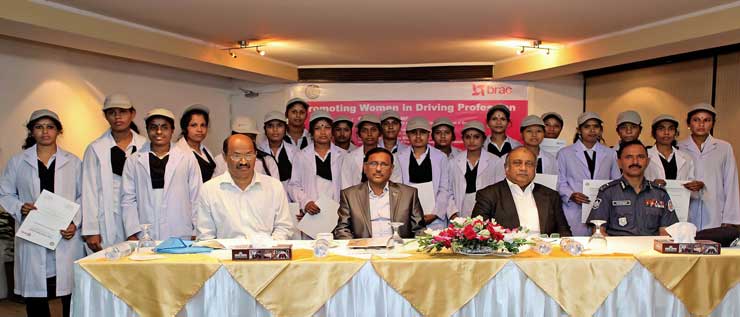
Women empowerment is deeply rooted in BRAC's values and is also reflected through BRAC Driving School. The project 'Four Wheels to Freedom' was initiated with the target to include women in driving profession and to provide an income generation skill to poor, disadvantaged women who would otherwise spend their life managing their households.
Under the project, a total of 75 women chauffeurs were trained through a two-month long residential training. After completion, they were presented with BRTA approved professional driving licenses, and today they are employed at reputed INGOs, MNCs, banks and other institutions in Bangladesh.
Shurakkha - defensive driving training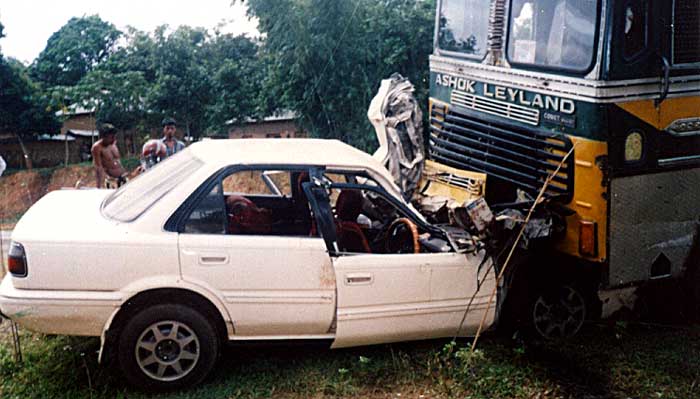
As the 2012 NRTA report stated, 1263 fatal road accidents saw the involvement of heavy vehicles on that year. The highways of Bangladesh see a major proportion of vehicular accidents that involve buses, goods carriers, human haulers and other types of heavy transport.
No matter how safe the vehicles or the vigilance of the general people, road safety cannot be achieved without driver’s training, skill and right attitude to drive safely. In light of this, BRAC Road Safety Programme introduced Shurakkha - a training targeted towards in-service commercial bus and truck drivers, majority of whom have not been through institutional driving training. It is common in Bangladesh where such drivers receive their training through apprenticeship from another experienced but uncertified driver. As a result, most of these drivers, although performing at professional capacity, are unaware of the many road safety rules and practices. This training is also fully residential.
Case stories:
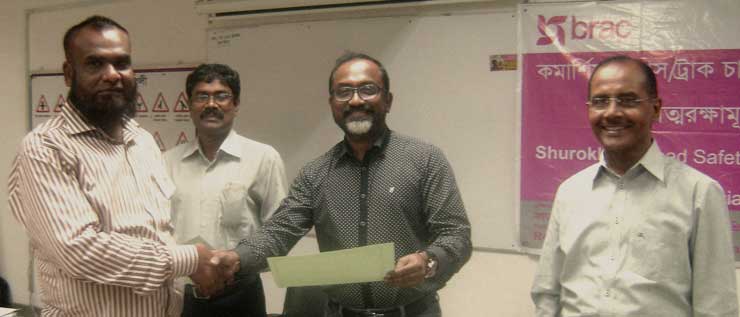
"The fuel consumption of the vehicles dropped by 30 per cent after our drivers took this training." - Mohammad Faruk Talukder Sohel (second from right), managing director, Shohagh Paribahan
"I've been driving professionally for ages but had no idea that there are so many things to consider while driving. Had I received this training earlier, I'd have been more careful." - Md. Abdus Sobhan, truck driver
"Once I fell asleep while driving and crashed into a roadside public event killing some people. Through this training I realised the importance of proper resting before driving." - Md. Ataur Rahman, truck driver
"I was involved in an accident where I collided with an auto-rickshaw and its driver passed away. All this time I believed it wasn't my fault. After the training, I understood that the cargo wasn't properly fastened to my truck. So, my truck took more distance to stop which resulted in the accident." - Md. Faisal Khondoker, truck driver
"I used to think that the white marks on the road bore no significance. From this training I understood what they mean. We must not overtake and drive on the other side." - Md. Monir, mini-bus driver
Basic driving training
Since November 2012, BRAC Driving School made its basic driving training facilities accessible for all. Anyone interested to take proper driving lessons under expert guidance are encouraged to get enrolled.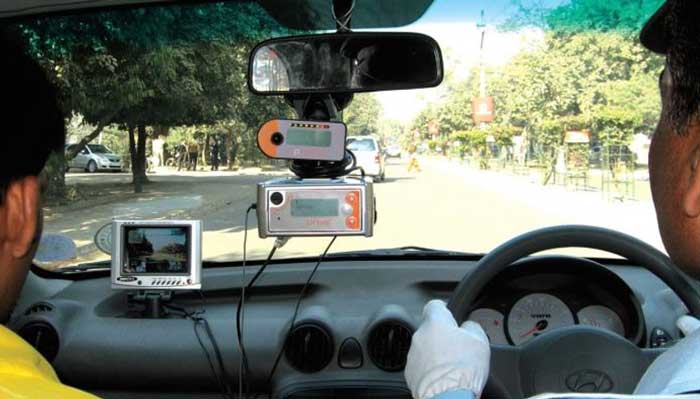
Training conducted with the P-Drive system
- Twelve days of residential Training of Instructors (TOI) for instructors of private driving training schools
- Thirty five days of non-residential basic driving training for all to obtain both professional and non-professional driving license
Facilities available:
- Modern driving simulator
- Visual impairment system
- Seatbelt convincer
- Dual controlled training vehicles
- P-Drive
Training of instructors
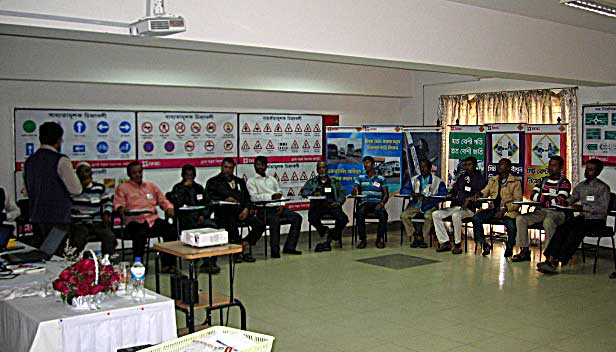
BRAC's monitoring department carried out a survey about the state of driving schools and driving instructors in the country, with the following findings. There were 362 driving training schools and 418 driving instructors in Bangladesh in 2012. Of these instructors, less than 108 had a legally required instructors license. BRAC Driving School introduced this training to fill the gap in terms of improving the quality of driving instructors in the country.
The school ensures that the trainee driving instructors know everything in order to conduct driving training: basic knowledge on driving, knowledge on road safety, and how to transfer their knowledge to their trainees. Driving instructors learn various tools, techniques and methods from this training.
These are some remarks on the training by former trainees:
“According to me, all the trainers of the entire country should do this course. If I didn’t receive this training, I would not have known that there is such a great training facility in Bangladesh.” – Al – Haj Mohammad Nurul Islam, trainer
“This course of BRAC is extraordinary. If this course is continued, it could bring about positive change in the professional driving arena of Bangladesh.” – SM Alamgir Hossain Babul, trainer
“The equipments they used and the training we received were marvelous. I think every trainer needs this type of training.” – Md. Salim Reza, trainer
“This type of training should be given to us once every year. My entire attitude has changed after coming here, thanks to BRAC.” – Md. Moshur Alam, trainer
“There is nothing more to say about this course, because it already is outstanding. I would like to say that the management should think about increasing the duration of this course to 15 days.” – AKM Fazlul Haque, trainer
BRAC Driving School signed an MOU with BRTA whereby trainees upon completion of the TOI training at the school can receive a driving instructors license from BRTA. Trainees of the course are taught in batches numbering 16 to 20 drawing resource persons from outside. Duration of this residential course is 12 days.
Address:
BRAC Learning Centre Uttara (Opposite of Hazrat Shahjalal International Airport and Hajj Camp), Dhaka – 1230
Mobile: 8801730374499, 8801730348531
BRAC Driving School (Gulshan)
Tejgaon Link Road (Niketon, Gate: 03), Gulshan, Dhaka- 1212.
Mobile: 8801704166301, 8801729071908
BRAC Driving School (Uttara R/A)
House-13, Road- 12, Sector- 12, Uttara, Dhaka- 1230.
Mobile: 8801713158265, 8801729070989
BRAC Driving School (Chattogram)
Choto Pole, Agrabad Access Road, Agrabad, Chattogram- 4100
Mobile: 8801891454899, 8801730347157
BRAC Driving School (Jashore)
Kathal tala main road (west side of Bablatala bridge), Sadar, Jashore- 7401
Mobile: 8801730322015, 8801773989899
BRAC Driving School (Rajbari)
Kallyanpur main road, Sadar, Rajbari- 7711
Mobile: 8801717809648, 8801729070562
Email: This email address is being protected from spambots. You need JavaScript enabled to view it. , This email address is being protected from spambots. You need JavaScript enabled to view it.
Road safety programme overview
As per the estimation by the World Health Organization, over 21,000 deaths occurred from road crashes in Bangladesh in 2015 with road traffic crashes equating to an estimated 1.6 per cent loss to the nation's GDP. The number of reported traffic fatalities per 100,000 population was 2.1048 in Bangladesh in 2013 (with 3,296 reported traffic fatalities and a population of 156,594,962). Furthermore, most affected families are driven into poverty from the loss of a family member who was a source of earning. BRAC's road safety programme identified key areas in Bangladesh where communities are exposed to risk of road accidents. These communities live very close to or beside the major highways. As part of engaging the communities, the programme activated several campaigns to raise awareness and help develop a sense of ownership of its own road safety.
Community road safety
In 2000, the government of Bangladesh requested BRAC to complement its efforts to improve road safety in the country. In 2001, BRAC decided to fullfill this request, both for the sake of the country and to protect its staff and programme participants. We chose to build road safety awareness, partly because of the insufficiency of road safety education in the formal education curriculum and the provision of information being passed along via word of mouth. Our approach was to involve the local communities, build their road safety capacity and road safety ownership, because our organisational experience has taught us that local ownership of development initiatives is crucial for achieving the desired outcome. As community road safety education is relatively new in the world - especially in developing countries, BRAC is a pioneer in community road safety initiatives in Bangladesh.
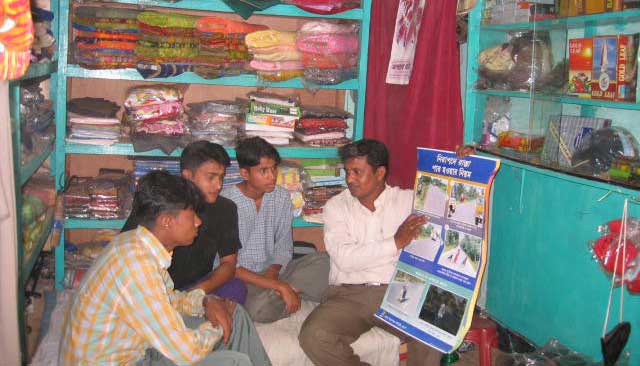
In 2003 BRAC was approached by UK’s Transport research laboratory (TRL) to carry out an action research project in community road safety education. By consulting local communities on their road safety problems, causes, solutions, preferred methods and messages for builing awareness, we designed a community road safety programme. The pilot project was done in partnership with TRLat Betila, and the project was very successful in making pedestrians aware of safe walking and crossing rules. This was the genesis of BRAC's road community road safety initiative and since then, (in consultation with local communities) BRAC has been improving the programme and have created new components while customising it to the needs of the particular communities.
Read more.
BRAC Driving School
The road safety related skills and attitude of drivers are huge factors determining public safety on roads. BRAC Driving School was started because there was a lack of good training facilities for in-service drivers, driving instructors, and novice drivers.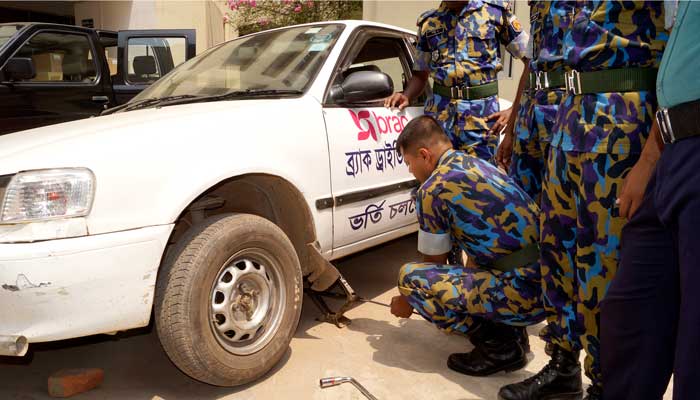
BRAC Driving School, a modern driving school in Bangladesh, was launched in 2012 by BRAC’s road safety programme. Earlier in 2011, in a meeting of the National Road Safety Council (NRSC), a decision was made that BRAC will take up a driving training project to train driving instructors and provide road safety training to in-service drivers considering the dismal state of drivers training in the country. After that, BRAC with the technical support of Hubert Ebner (India) Pvt Ltd prepared training materials and conducted the training of trainers (TOT).
Read more.
Advocacy: Promoting Safe Road Code project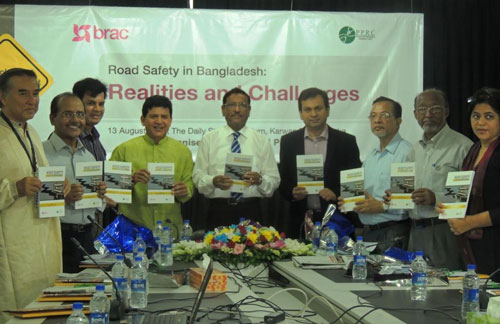
Together with BRAC's advocacy for social change programme, the road safety programme has also worked on an advocacy project called 'Promoting Safe Road Code’. In this three year project (2013 – 2015) it was proposed that a safe road code would be drafted in consultation with relevant stakeholders and experts to be promoted afterwards. This code would describe important rules and regulations which should be followed by all road users. However, during the project the government of Bangladesh designed and considered new traffic laws (RTA), after which the safe road code was held redundant by BRAC. As a result, instead of the safe road code, the great importance of road safety in general was promoted. BRAC also organised some national level discussions to improve the proposed road traffic act (RTA). Another major activity was conducting a research on road safety carried out by Power and Participation Research Center (PPRC). A higher goal of the project was to create an enabling environment for the road safety programme. As communities, local and national policy makers, other authorities, and service providers such as the BRTA have been sensitised on and mobilised for road safety, future activities of the road safety programme can receive more support.
We mourn for Dr Babar Kabir
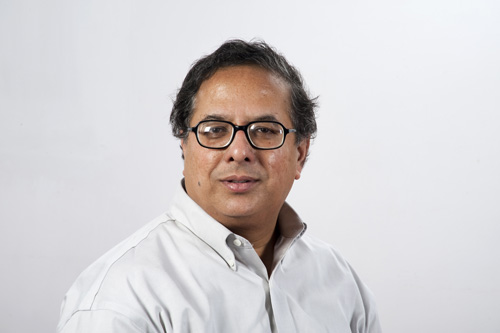
BRAC mourns the sad demise of Dr Babar Kabir who was the former senior director of BRAC's disaster management and climate change and water, sanitation and hygiene programmes. On the morning of 15 January at around 7 am, after a severe asthma attack, he succumbed to a cardiac arrest in Dhaka. He is survived by his wife and two daughters.
Dr Kabir completed his PhD in hydrogeology in 1986 from Azerbaijan State University and has been working in the field of environment and public health since then. He has served in the capacity of senior management roles at the World Bank-WSP, UNDP Bangladesh, Ministry of Environment and Forest, Government of Bangladesh as national programme coordinator for their Sustainable Environment Management Programme (SEMP), and other multilateral and bilateral organisations. In 2007, Dr Kabir joined BRAC as director of its water, sanitation and hygiene (WASH) and disaster management and climate change (DMCC) programmes, and in 2012 he became a senior director. He was also a member of the Executive Management Committee, which is BRAC’s management decision making committee.
Hinged on his leadership, BRAC provided more than 37 million people with hygienic sanitation and another two million with access to safe water in 250 sub-districts of Bangladesh. And in 2013, after the Rana Plaza disaster, BRAC reached out to number of survivors through health protection scheme, fixed deposit, skills development training for different livelihood followed by seed funding as investment to begin new life and psychosocial counselling to cope with post-traumatic stress disorder.
In 2014, Dr Kabir left BRAC to become a consultant in the WASH and microfinance sectors. He has over 15 publications in national and international journals and has co-authored a chapter on ‘Mitigation Strategies’ of the WHO monograph on arsenic initiated by UNACC.
Today, the BRAC family is deeply saddened by the departure of such a dynamic leader and a brilliant mind that came out of this nation.
The Story Behind the 2015 World Food Prize Laureate
When the non-profit BRAC was set up over 40 years ago, it was a temporary effort aimed at helping rural populations that had been affected by a devastating cyclone and civil war. Today, BRAC is one of the biggest NGOs in the world, and responsible for lifting 150 million people out of poverty. Farming First TV had the opportunity to interview BRAC’s Founder, Sir Fazle Hasan Abed at the Borlaug Dialogue in Iowa, where he was honoured as the 2015 World Food Prize Laureate, to find out the secrets of success behind the Bangladesh-based NGO.
For centuries, Bangladeshi farmers had faced a hunger season, known as monga. Sir Fazle told Farming First how giving farmers access to rice varieties that matured more quickly allowed a third crop, potatoes, to be planted in between the two rice growing seasons. “It was long assumed to be a part of the enduring fabric of rural life in northwest Bangladesh. But today, we are starting to see the disappearance of monga and, in many places it has gone completely,” he commented.
“We have…succeeded in disrupting a pattern of suffering that had prevailed for centuries”
Providing farmers with finance and access to markets in order to sell their produce, was a second strand of activity that BRAC undertook in order to help rural people prosper. Sir Fazle told us how he had seen that farmers in rural areas were not getting a fair price for their milk.
“I thought, if we could collect milk… refrigerate it, and transport it to Dhaka, we could easily pay (the farmer) 15 taka per litre — roughly twice what she was getting at that time — and still cover our costs. This led to the establishment of the BRAC Dairy enterprise.”
BRAC now operates several social enterprises, that are all focussed on providing high quality inputs and services for the poor. These businesses generate $150 million in profit each year, which is all directed into financing BRAC’s non-for profit work such as healthcare and education.
For more information on Sir Fazle Hasan Abed and BRAC’s work, visit the World Food Prizewebsite.
Join the world’s biggest family




